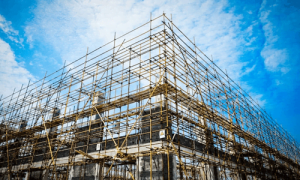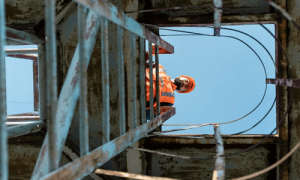Scaffolding is a necessary item for building and maintenance tasks that need working at heights.
While it is convenient for construction and maintenance, a scaffolder may be in a dangerous position if necessary safeguards and working at heights control procedures are not taken.
So, in this article, we will discuss the hazard in scaffolding as well as the precautions a scaffolder should take to ensure their safety.
Before that, we’ll tell you what exactly a scaffolder does in this line of work.
What Does A Scaffolder Do?

A scaffolder’s job is to assemble, erect, and dismantle temporary metal or timber structures and platforms.
Crew members can work safely at high heights thanks to these buildings and platforms.
They review the designs and blueprints of a construction project to determine the best scaffolding materials.
They bolt these materials together according to processes and guidelines, utilizing tubes, pipelines, support bracing, and clamps, to secure them or form a reconfigurable frame.
Then, they secure the scaffolding poles to the structure. To avoid damaging what’s beneath the scaffolding, it may need to be adjusted or reconfigured.
Scaffolders use a lorry to lift and position sections of scaffolding together, forming a secure ground basis from which to build. They place planks on the ground for the team to walk on and hold tools.
Furthermore, guardrails, guy wires, ropes, clamps, and hanging safety nets are installed to collect dropped tools.
Depending on the situation, they may build simple platforms or suspended or cantilever scaffolding.
They secure the scaffolding and confirm its safety before handing it off. They also disassemble it after building is completed to ensure that the site is neat and clean.
6 Hazard in Scaffolding

1. Slipping of an unsecured ladder
Workers may fall while climbing a ladder, especially if the ladder is not properly secured.
This can result in severe injuries or even death.
2. Use of inappropriate, damaged, or faulty materials
Scaffolding must be built with appropriate materials and tested on a regular basis to ensure it is in good shape.
Materials that are faulty or broken might cause the structure to collapse, resulting in significant injuries or fatalities.
3. Scaffold boards that are not adequately supported
To reduce the possibility of collapse, scaffold boards must be adequately supported.
Workers can fall from great heights if they are not properly supported, resulting in catastrophic injuries or fatalities.
4. Guard rail omission/removal
Guard rails are critical in preventing falls from great heights.
Workers are at risk of falling from the scaffolding if they are omitted or removed.
5. Inadequate tie-in/braced
Scaffolding must be securely tied-in and braced to avoid tipping.
Failure to do so might result in serious injury or even death.
6. Platform and board overload
Overloading the scaffold platform and boards can lead to the structure collapsing, resulting in catastrophic injuries or fatalities.
Read More; Tuntutan PERKESO: Program Saringan Kesihatan (HSP) 3.0
Good Practice When Handling Ladder
1. The ladder should be of the industrial variety
When scaffolding , it is best to use an industry type of ladder.
Industrial ladders are designed to withstand the rigors of daily use in a workplace environment.
2. Select the appropriate sort of ladder for the job
Different types of ladders are required for various jobs.
To guarantee safety, always use the appropriate ladder for the job.
3. Before using the ladder, inspect it for flaws and damage
Always inspect a ladder before using it for flaws, cracks, or damage.
If any are discovered, the ladder should be avoided until it has been repaired.
4. Independent ladders must be labeled
Independent ladders should be labeled with the date of inspection and the inspector’s name.
The tag should be valid for one month use only.
5. The ladder must be positioned at a 75-degree angle
To maintain stability and safety, ladders should be positioned at a 75-degree angle from the ground.
6. The ladder must be clamped in three places
Ladders should be clamped in three places to avoid slipping and sliding.
In conclusion, a scaffolder should take precaution in scaffolding to avoid not only bodily injury, but also to ensure a smooth construction process.
Accidents can always happen in the workplace. Other than practicing best safety precautions, employers should take a proactive approach to ensure this won’t happen.
There are many types of proactive approach you can take such as:
- Regular medical check-ups in accordance with OSHA 2022 regulation.
- Medical & noise surveillance for workers exposed to chemical hazards and noisy working environments.
- Employee wellness programs for non-communicable diseases such as obesity, hypertension and stroke.
- Mental health support to reduce and minimize psychosocial hazard.
- Ergonomic workplace to prevent work-related musculoskeletal diseases.
All of this can be obtained by subscribing to OHPlus services!
OHPlus is an integrated platform that provides an efficient end-to-end occupational health solution to Malaysian employers, especially small and medium-sized enterprises (SMEs).

With OHPlus, you get rapid access to a vast pool of highly experienced and thoroughly validated occupational health specialists.
Multi-disciplinary teams of professional health professionals, including OH Doctors, OH Nurses, Ergonomics, Hygienists, and Industrial Psychologists, may provide guidance and advice.
Our services are technologically oriented, as employees may use our site to track and monitor their development as well as save health records.
Book your consultation now with OHPlus!


